![]()
![]()
![]()
Use LEFT and RIGHT arrow keys to navigate between flashcards;
Use UP and DOWN arrow keys to flip the card;
H to show hint;
A reads text to speech;
23 Cards in this Set
- Front
- Back

A. Describe the purpose/function. |
SSEE Increment E/F
- Ships Signal Exploitation Equipment. - Part of ship’s tactical cryptologic systems (TCS) suite. - Allows operators to monitor and analyze signals of interest aboard a variety of ship classes. |
|
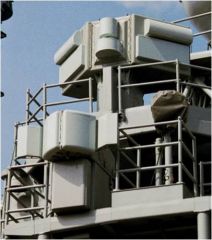
A. Describe the purpose/function.
B. How does the IDC use this system to support operations? |
AN/SLQ-32(V)
(V)1: simple threat warning receiver; phased out. (V)2: receives surveillance and targeting radars = passive targeting capability for Harpoon missile-equipped ships. (V)3: active radar-jamming capability. (V)4: designed for installation on aircraft carriers. (V)5: compact version of the (V)3 system intended to give active jamming capability to the Perry class FFG’s, which were too small to carry a full (V)3. |
|
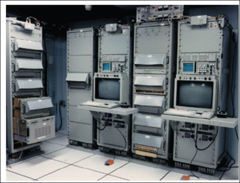
A. Describe the purpose/function.
B. How does the IDC use this system to support operations? |
AN/SRS-1, Combat DF
- Combat Direction Finder. - Automated long range hostile target signal acquisition and direction finding system that can detect, locate, categorize and archive data into the ship's tactical data system. - Electronic support, signal acquisition, and direction-finding system provides warship commanders near-real-time indications and warning, situational awareness, and cueing information for targeting systems. |
|
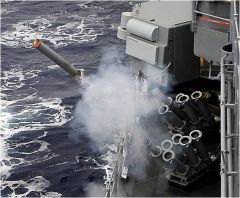
A. Describe the purpose/function.
B. How does the IDC use this system to support operations? |
MK 36, DLS
- Decoy Launching System with Super Rapid Blooming Offboard Chaff (SRBOC). - Short-range mortar that launches chaff or infrared decoys from naval vessels to foil anti-ship missiles. - Each launcher has four tubes set at a 45-degree angle, and two tubes set at a 60 degree angle, providing an effective spread of decoys and countermeasures to defeat radio frequency emitting missiles. - Can also be fitted with the TORCH infrared "flare" decoy system. |
|
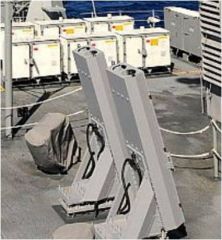
A. Describe the purpose/function.
B. How does the IDC use this system to support operations? |
MK 53, DLS
- Commonly referred to as “NULKA” (in the Australian Aboriginal dialect, "Nulka" means "be quick!"). - Rapid response Active Expendable Decoy (AED) System capable of providing highly effective defense for ships of cruiser size and below against modern radar homing anti-ship missiles. - Intended to counter a wide spectrum of present and future radar-guided anti-ship missiles (ASMs) assessed to have passive decoy rejection and active angular deflection electronic countermeasures rejection capabilities. |
|
|
A. Describe the purpose/function.
B. How does the IDC use this system to support operations? AN/ULR-21 TROLL/ISCRS |
- Integrated Submarine Communications Receiving System.
- New Attack Submarine (NSSN) Electronic Support Measures (ESM) System - Formerly called ASTECS - Advanced Submarine Tactical ESM Combat System. - Will develop a new ESM system that will support operations in both the open-ocean environment and the complex littoral signals environment. - Provides detection, identification, and direction-finding for radar and communication signals emanating from ships, aircraft, submarines, and other emitters. |
|
|
A. Describe the purpose/function.
B. How does the IDC use this system to support operations? AN/USQ-113 |
- Communications Jammer.
- EA-6B Growler communications countermeasures set (CCS) to locate enemy communication channels and disrupt communications. |
|
|
A. Describe the purpose/function.
B. How does the IDC use this system to support operations? AN/ALQ-99 |
- Tactical Jamming System (TJS).
- Intercepts and automatically processes radar signals and power manages the system's transmitters to effectively jam large numbers of diverse radar threats with very high effective radiated power (ERP). - Capable of intercepting, automatically processing and jamming received radio frequency signals. - Receivers can also be used to detect, identify and direction find those signals, providing signals intelligence (SIGINT) either automatically or manually. |
|
|
A. Describe the purpose/function.
B. How does the IDC use this system to support operations? UYX-4 SEI |
- Specific Emitter Identification technology.
- Provides a reliable, long-range, all-weather positive target identification capability against seaborne platforms and land-based systems that emit radar signals. - A network of geographically separated SEI-equipped aircraft, ship, and land-based platforms operating in a networked environment provide time-critical, tactically relevant Electronic Intelligence (ELINT) that contribute to early Indications and Warning (I&W) of suspected hostile vessels, enhance the commander's situational awareness, and assist in forming courses-of-action. |
|
|
A. Describe the purpose/function.
B. How does the IDC use this system to support operations? RADIANT MERCURY |
Software application that automatically sanitizes, guards, and downgrades multi-level classified, formatted information, to allow its release to users (primarily tactical users) not authorized access to more highly classified data.
|
|
|
A. Describe the purpose/function.
B. How does the IDC use this system to support operations? AN/USQ-146 |
- Off-the-shelf dual receiver-transmitter that provides conventional AM/FM voice and data communications, multiband surveillance scanning, target detection, identification and analysis.
- Allows multi-waveform jamming of targeted signals in the 20 to 2,500 MHz frequency range. |
|
|
A. Describe the purpose/function.
B. How does the IDC use this system to support operations? AN/SSX-1 |
- Electronic warfare system that supports a variety of missions including maritime interdiction operations against weapon, chemical and drug smuggling.
- Collects precision electronic parametric data and correlates it to specific transmissions from ships and aircraft searching for potential matches. - Designed for the US Navy's Surface Electronic Warfare Improvement Program (SEWIP) which is an upgrade to the AN/SLQ-32 electronic warfare anti-ship missile defense system. |
|
|
A. Describe the purpose/function.
B. How does the IDC use this system to support operations? JTT/CTT |
- Joint/Commander’s Tactical Terminals.
- Family of special application UHF tactical intelligence terminals which provide the capability to disseminate time sensitive C4I and battlefield targeting information to tactical commanders and intelligence nodes. - Information is provided in near-real-time and allows selected collection managers at all echelons a full-duplex capability to dynamically adjust pre-planned tasking. |
|
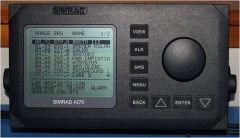
A. Describe the purpose/function.
B. How does the IDC use this system to support operations? |
AIS
- Automatic Identification System. - Automatic tracking system used on ships and by Vessel traffic services (VTS) for identifying and locating vessels by electronically exchanging data with other nearby ships and AIS Base stations. - Supplements marine radar, which continues to be the primary method of collision avoidance for water transport. |
|
|
A. Describe the purpose/function.
B. How does the IDC use this system to support operations? DRT |
- Dead Reckoning Tracer
- Mechanical computer that plots the location of the ship on a paper chart, based upon a known start location and a series of inertial inputs. - The DRT operator places a piece of tracing paper on top of the glass and periodically marks lighted ship positions projected onto the paper from beneath the glass and bearings to contacts. - Typically located in ship’s CIC (combat information center) |
|
|
A. Describe the purpose/function.
B. How does the IDC use this system to support operations? DCGS |
- Distributed Common Ground Systems.
- Defense Airborne Reconnaissance Office (DARO) vision for the integrated architecture of all ground/surface systems. - Establishes the core framework for a worldwide distributed, network centric, system-of-systems architecture that conducts collaborative intelligence operations and production. - Family of fixed and deployable multi-source ground processing systems that support a range of intelligence, surveillance, and reconnaissance systems such as national and commercial satellite systems, U-2, Unmanned Aerial Vehicles (UAVs), and F-16 Theater Airborne Reconnaissance Systems (TARS). |
|
|
A. Describe the purpose/function.
B. How does the IDC use this system to support operations? JCA |
- Joint Services Imagery Processing System (JSIPS) concentrator architecture (JCA).
- Developed for the fast and efficient delivery of imagery while providing increased flexibility in bandwidth management. - Client-server based architecture, with web-like browsing features and capabilities for fleet imagery subscribers. Provides the fleet with a SECRET, GENSER, user-friendly network-centric, imagery delivery system. |
|
|
A. Describe the purpose/function.
B. How does the IDC use this system to support operations? GALE-Lite |
- Generic Area Limitation Environment.
- Computer application used to display and manipulate intelligence information. - Provides cartographic data management; user-definable visualization environment; space, time, and movement modeling; sensor modeling; and data fusion. |
|
|
A. Describe the purpose/function.
B. How does the IDC use this system to support operations? GCCS-J/M (GENSER and SI) |
- Global Command and Control System.
- Maritime - receives, processes, displays, and manages data on the readiness of neutral, friendly, and hostile forces in order to execute the full range of Navy missions in near-real-time via external communication channels, local area networks (LANs) and direct interfaces with other systems. - Joint - provides a robust and seamless C2 capability to the Combatant Commands, SECDEF, NMCC, CDRs, JFCs, and Service Component Commanders; offers vital connectivity to the systems the joint warfighter uses to plan, execute, and manage military operations. - Full-duplex General Service (GENSER) and Sensitive Compartmented Information (SCI) connectivity. |
|
|
A. Describe the purpose/function.
B. How does the IDC use this system to support operations? Turbulent Wave |
- Provides capability for real-time remote, shipboard access to national SIGINT collection and processing resources.
- Provides Seawitch and NSANET capabilities. |
|
|
A. Describe the purpose/function.
B. How does the IDC use this system to support operations? NITES |
- Navy Integrated Tactical Environmental System.
- Software suite of METOC applications, services, and data servers that are used for both oceanographic and meteorological forecasting, weapon system performance prediction, and sensor detection/counter-detection capabilities. - Used to produce detailed meteorological and oceanographic data displays (e.g., wind speed/direction, air pressures, sea-state) along with the effects of these physical environmental parameters on military operations. |
|
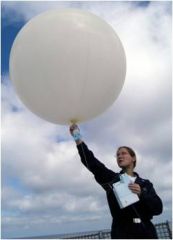
A. Describe the purpose/function.
B. How does the IDC use this system to support operations? AN/UMQ-12 |
- Mini rawinsonde system (MRS).
- Measures air pressure, temperature, humidity, wind speed, and wind direction in troposphere and lower stratosphere. - Measurements based on the use of a free-flying expendable meteorological sonde (attached to a weather balloon), which transmits pressure, temperature, and humidity measurements to the AN/UMQ-12 over a radio link. - Highly compact, portable system ideal for shipboard, mobile team, and field use. |
|
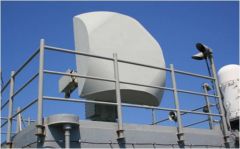
A. Describe the purpose/function.
B. How does the IDC use this system to support operations? |
- METOC Satellite Receiver Processor.
- Stand-alone environmental satellite ground receiver. - Capable of receiving raw imagery data in the visible, IR, and water vapor wavelengths from both the military Defense Meteorological Satellite Program (DMSP) and the NOAA TIROS polar orbiting satellites. - Satellite pictures and a limited selection of weather charts can be received from the GOES satellites on the WEFAX channel. - Digitally interfaced to the NITES 2002. |

